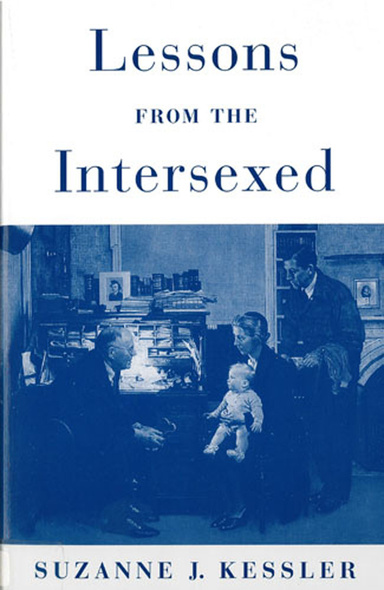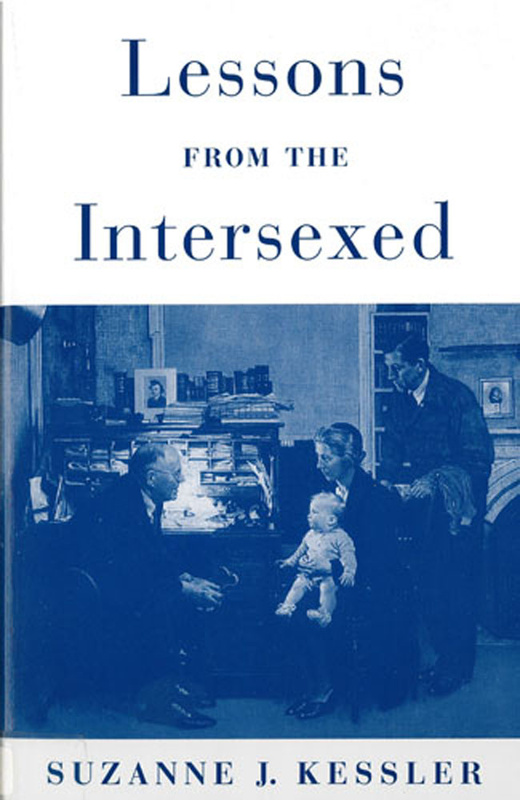From the moment intersexuality-the condition of having physical gender markers (genitals, gonads, or chromosomes) that are neither clearly female nor male-is suspected and diagnosed, social institutions are mobilized in order to maintain the two seemingly objective sexual categories. Infants' bodies are altered, and what was "ambiguous" is made "normal." Kessler's interviews with pediatric surgeons and endocrinologists reveal how the intersex condition is normalized for parents and she argues that the way in which intersexuality is managed by the medical and psychological professions displays our culture's beliefs about gender and genitals.
Parents of intersexed children are rarely heard from, but in this book they provide another perspective on reasons for genital surgeries and the quality of medical and psychological management. Although physicians educate parents about how to think about their children's condition, Kessler learned from parents of intersexed children that some parents are able to accept atypical genitals. Based on analysis of the medical literature and interview with adults who had received treatment as interesexed children, Kessler proposes new approaches for physicians to use in talking with parents and children. She also evaluates the appearance of a politicized vanguard, many of who are promoting an intersexual identity, who seek to alter the way physicians respond to intersexuality.
Kessler explores the possibilities and implications of suspending a commitment to two "natural" genders and addresses gender destabilization issues arising from intersexuality. She thus compels readers to re-think the meaning of gender, genitals, and sexuality.
"This is a brave book. Kessler says things that need to be said, and she says them clearly, concisely, and with respect for the people whose lives are most affected by the questions she confronts. A must read for anyone concerned with intersex issues." --Holly Devor, author of Gender Blending: Confronting the Limits of Duality and FTM: Female-to-Male Transsexuals in Society.
"While the physician's response to an infant with ambiguous genitalia has been to produce categories like the 'successful vagina' and the 'good enough penis,' Kessler takes her cues from intersexuals themselves. This book is a brilliant and long overdue call for the reevaluation of gender variability." --Judith Halberstam, author of Female Masculinity
"Fascinating in what it tells us not only about situation in which sex assignment is uncertain but about the astonishingly weak empirical foundations on which the medical orthodoxies of binary sex and gender are built. A must for anyone interested in the ways widely accepted social beliefs and scientific explanations generate and reinforce each other." --Ruth Hubbard, author of The Politics of Women's Biology and Exploding the Gene Myth
Lessons from the Intersexed concerns how modern medicalized Western culture deals with sexual variation. Throughout, Kessler holds that variation is normal . . . and thus sees many treatment modalities for intersexuality as medically questionable, culturally dogmatic, and ethically very dubious. Although Lessons from the Intersexed does record a devilÆs garden of botched surgical and endocrinological interventions, it is neither a hot-headed rant nor a popular book retailing medical horror stories. Instead, Kessler writes with clear ethical purposes for a professional audience to ask what intersexuality is, and what we should do about it, if anything.
Lessons from the Intersexed is an incisive look at the fifty-year-old Western medical practice of surgically reconstructing the bodies of infants born with genitals that do not look wholly female or male. . . . KesslerÆs academic publication is the first to expose the medically acceptable range for the genitals of a newborn (0.2 cm to 0.85 cm for an infantÆs æclitoris,Æ 2.5 cm to 4.5 cm for an infantÆs æpenisÆ). We see that, in fact, it is the decision of the attending surgeon that determines whether or not a parent goes home with a little girl or a little boy.
This is a brave book. Kessler says things that need to be said, and she says them clearly, concisely, and with respect for the people whose lives are most affected by the questions she confronts. A must read for anyone concerned with intersex issues.
While the physician's response to an infant with ambiguous genitalia has been to produce categories like the æsuccessful vaginaÆ and the ægood enough penis,Æ Kessler takes her cues from intersexuals themselves. This book is a brilliant and long overdue call for the reevaluation of gender variability.
Fascinating in what it tells us not only about situations in which sex assignment is uncertain but about the astonishingly weak empirical foundations on which the medical orthodoxies of binary sex and gender are built. A must for anyone interested in the ways widely accepted social beliefs and scientific explanations generate and reinforce each other.
1 Introduction
2 The Medical Construction of Gender
3 Defining and Producing Genitals
4 Evaluating Genital Surgery
5 Questioning Medical Management
6 Rethinking Genital and Gender
Notes
Glossary
Biography
Index





